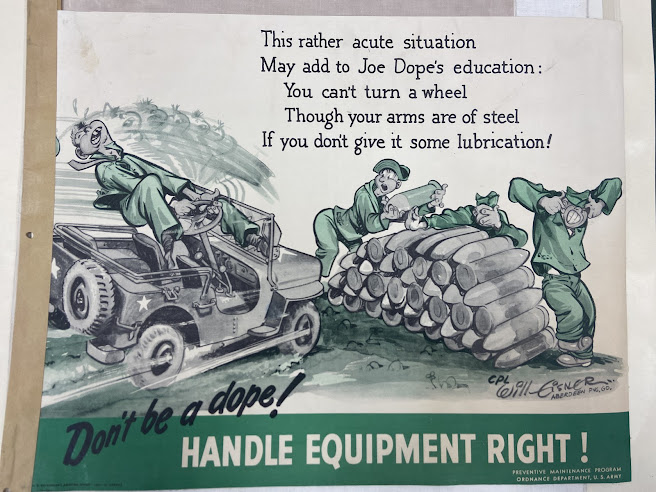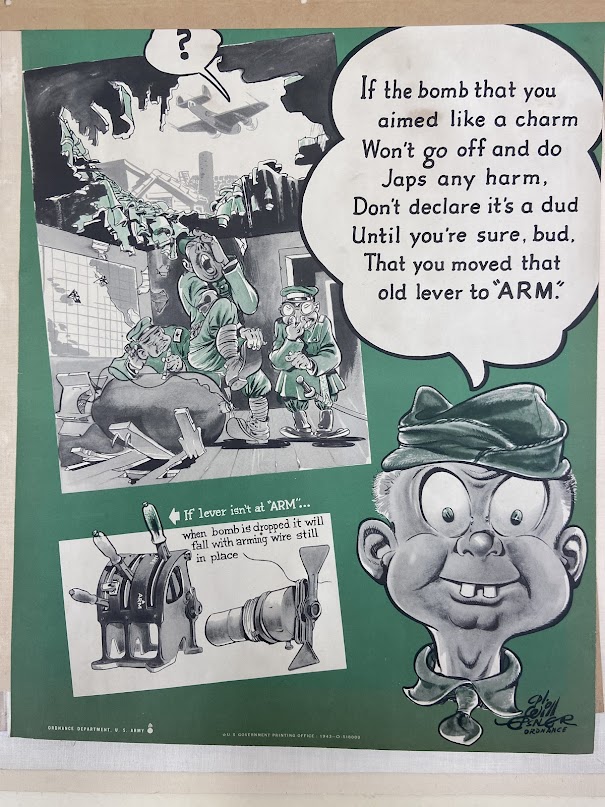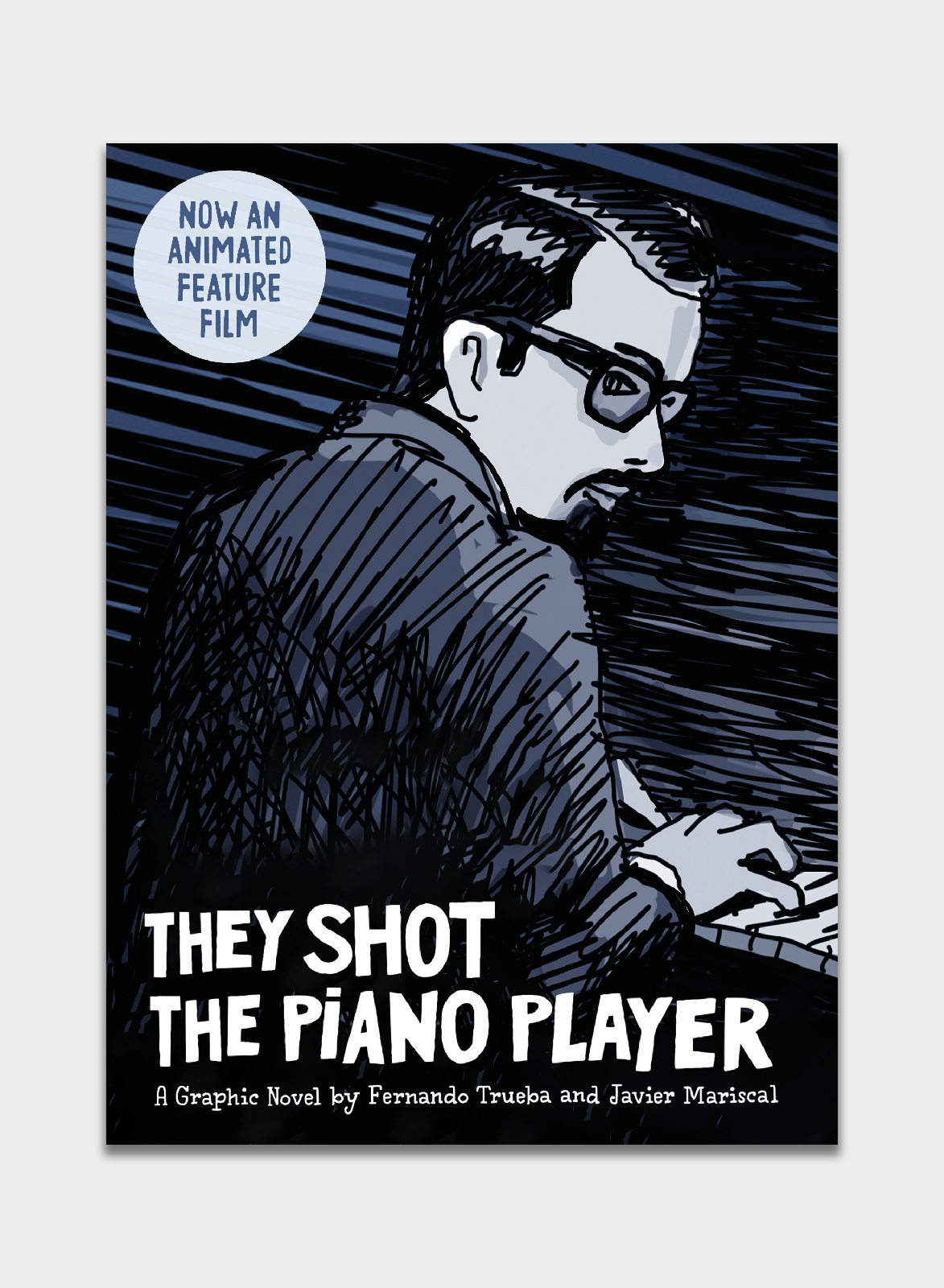by Warren Bernard
It was clear to US Army leaders after the blitzkrieg of 1939-1940, where German tanks overran first Poland and then most of Western Europe in a matter of weeks, that World War II would be conducted with mechanized warfare to a far greater degree than previous wars. The numbers of vehicles (tanks, half-tracks, cargo trucks, troop transports, etc.) would dwarf those built during the World War I. Mobility of troops and supplies in the war would be paramount, and to that end by 1945 the United States alone produced over 2.3 million trucks, 640,000 jeeps and 88,000 tanks, plus tens of thousands of other vehicles.[i]
The Army also controlled the air force (known then as the Army Air Force), which would not become a separate branch of the armed services until 1947. Planes, of which the United States produced 297,000 by the war’s end[ii], added more stress to maintenance duties around the world in that their engines, landing gear, bombs, bomb bays, machine guns and other parts / systems would need regular servicing and a high degree of mechanical skill.
Working against the Army’s needs at this time was the education level of the typical draftee. In 1940 only 25% of males over the age of 25 had a high school degree, with high school graduation numbers just over 50%.[iii] There was an overall literacy issue in the armed forces because of these societal deficiencies. New methods needed to be implemented to train not only front-line soldiers how to care for their equipment, but also the mechanics and other support troops spread around the world to service planes and mechanized units.
Into this educational void was thrust William Erwin Eisner (1917-2005). One of the pioneers of comics, his creation The Spirit, that ran as a comic book newspaper supplement from 1940-1952, is considered one of the great hero characters of The Golden Age of Comics (1938- ca.1956). Eisner's use of splash pages, innovative panel layouts and adult-aimed stories influenced many comic books artists in subsequent generations. He is also considered either a father or godfather to the form of the graphic novel, as both an advocate and creator in that genre, although historically he did not invent the graphic novel concept.
Eisner received his draft notice in December 1941, soon after the United States declared war after the Japanese bombing of Pearl Harbor. At that time, he was running a comics production shop that published The Spirit, along with providing Quality Comics and other publishers with complete comic book stories.[iv] He was able to defer his enlistment to take care of setting up his business to run in his absence until he was inducted May 1942.[v] Eisner’s basic training was at Fort Dix, New Jersey, after which he was posted to the Aberdeen Proving Grounds in Maryland. It was there that Eisner came up with the idea to use comics to help train army troops, creating the character of Joe Dope to exemplify what one should not do to their equipment. This idea was embraced by his commanding officer, who then transferred him to the Holabird Ordnance Center in Baltimore.
On September 7, 1942, the Adjutant General of the Army, James Ulio sent out an order that effective that month, Joe Dope posters were being distributed to all “posts, camps and stations” around the world. The backs of some of the posters have the original order, along with instructions on where to hang the posters. Below the hanging instructions, Eisner drew a cartoon emphasizing the proper placement of the poster.
Per Ulio’s orders, the first three posters were issued every two weeks starting in September 1942, and that posters were to be distributed weekly after that. It is clear from the research that this rate of poster publication was never fulfilled, as to date only 52 of these posters have been identified after research from the National Archives (NARA), Library of Congress (LoC), private collections, and auction sites. The posters covered a wide range of equipment, including machine guns, trucks, tanks, mortars, and planes, among others. They also gently prodded supply depots to fill out the correct forms and not over order or hoard spare parts. Fifteen of the posters were specifically made for the Army Air Force, with seven other posters made for the Pacific Theater. Though it is known that there were 20,000 of the first posters printed, additional research is needed to see if any documentation exists for the actual print run totals. It is not known at this point whether Eisner chose the poster topics or they were assigned to him.
While at Holabird, Eisner joined the staff of Army Motors magazine that was published there for distribution to all army bases around the world for mechanics, soldiers, and support staff. Army Motors began its publication history in May 1940 as an 8 ½” x 11” text-only, black and white mimeographed publication. By the time Eisner came on board in mid-1942, it was still the same size, but now it was staple-bound with a spot-colored cover. The interior used photographs and line drawings to communicate different aspects of maintaining equipment. A wide range of topics were covered in Army Motors, from maintenance issues with tanks, to how to prepare trucks for use in cold weather and how to lubricate a jeep, among thousands of topics covered during its 5-year run.
The November 1942 issue of Army Motors introduced Eisner’s Joe Dope to the Army:
Joe Dope is the doggondest fool in the Army!!!!
A new character with a desperate destiny designed to call attention to habitual failures in maintenance of all Army equipment. Humor without bitterness but stinging with its truthfulness. Joe Dope posters will drive home a point quickly…. And with little or no pain!
The posters of Joe Dope were successful enough to spawn a two-page comic strip by Eisner that began in the April 1944 issue of Army Motors, continuing until the magazine ceased publication in September 1945. Eisner would resurrect Joe Dope during the Korean War in 1951, when he left his creation, The Spirit, behind to become a government contractor. He used Joe Dope as the centerpiece in his new undertaking, PS: The Preventive Maintenance Monthly, for the U.S. Army.[vi] Covering the same topics of equipment maintenance, PS magazine was an updated and expanded version of Army Motors, down to the use of the digest format Eisner had introduced for Army Motors in the summer of 1944. Eisner remained with PS for twenty years until 1971, at which point he returned to the comics field as a teacher and the creator of new works that would renew his stature as one of the greats in the world of comics.
This attempt to create a catalogue raisonné listing all of Eisner’s Army posters was conducted over a period of years, and the following information was captured: Artificial title using 1st line of rhyme; year; Eisner's rank; Eisner's organization (as signed on poster); audience; LoC / NARA holdings; Government Printing Office # / other ID; LoC received date; notes. The information is presented in two ways - as a caption to an image of the poster, and as a table at the end of the article.
A rock to Joe Dope is a trifle 1942 Pvt. Aberdeen Pvg. Gds. Both (LoC and NARA) 478618

At maneuvers Joe Dope took a tank 1942 Pvt. Both 481419

In helping assemble a mortar 1942 Pvt. Both 481418

Joe Dope camouflaged his Garand 1942 Pvt. Aberdeen Pvg. Gds. Europe Both 478615 
Joe Dope has a vague premonition 1942 Cpl. Both 498371

Joe Dope has a way that's unique 1942 Pvt. Both 481417 2/15/1943
Joe dope has the habit, we fear, 1942 W/O LoC None 1/13/1943

Joe Dope is a guy you can't teach 1942 Pvt. Ord. Tng. Division Both 481420 2/26/1943

No obstacle that he may meet 1942 Pvt. Aberdeen Pvg. Gds. Both 478619

The book says to run a car right 1942 Cpl. Europe Both 498372 2/18/1943

The Sheik thinks it terribly strange 1942 Cpl. Ordnance Dept North Africa Both 498733 2/2/1943
The tank crew is sore as a boil 1942 Pvt. Both 478620
When the Stukas begin to attack 1942 W/O Ordnance Both 553727

A maxim Joe Dope just pooh poohs 1943 W/O Both 10/11/1943

Aloft in the thick of the fight 1943 W/O AAF Both 562295 1/19/1944

At fixing things I'm a bear! 1943 W/O Ordnance Both None 9/1/1943

Behold Joe Dope hitting his stride 1943 W/O AAF Both 553727

I'm tired of taking the rap 1943 W/O Ordnance AAF Both 10/11/1943
If the bomb that you aimed like a charm 1943 Cpl. Ordnance AAF, Pacific LoC 518000 
Joe Dope is a regular ace 1943 W/O Ordnance Both None 10/11/1943
Joe Dope says "Should I get KP... 1943 W/O Ordnance AAF LoC PMU Holabird A-6 8/26/1943

Joe Dope says, "Why bother to clean... 1943 CWO Ordnance NARA 565905

Joe Dope should get thrown in the can 1943 W/O Ordnance AAF, Pacific Both 518000

Joe Dope thinks it funny to play 1943 W/O Ordnance AAF, Pacific BotH 518000 4/24/1943
Misled by publicity stuff 1943 W/O Ordnance NARA 553727
No friends, this is not the location 1943 None Ordnance LoC 7/13/1943
The poet says "What's in a name?" 1943 Warrant Officer NARA 562294 Verso has letter from Adjutant General and illiustration by Eisner as to how to hang them
These pilots will "gently" explain 1943 W/O AAF Both 518000
To prove he's game as the flyers 1943 Cpl. Ordnance Both 512339
While draining the oil one day 1943 Unsigned Both 512339 5/8/1943
"Who's (sic) 'borrowed' the damn arming wire 1943 W/O Ordnance AAF LoC 552727 
With an air of complete unconcern 1943 CWO Ordnance Both 565904
Don't hoard spare parts 1944 CWO Both 577520 (non-limerick)
Don't wash vehicles in... 1944 CWO Pacific Both 595006 8/25/1944 (non-limerick)

Joe Dope isn't bug-house or crazy 1944 [Ordnance] Both 62235 Maybe not Eisner? No signature, does not look like his art
Joe Dope takes good care that his hide 1944 Unsigned AAF, Pacific Both 569901

Joe Dope, friends, has done it again 1944 CWO Pacific Both 569902

Shock absorbers left to get dry 1944 Unsigned Ordnance Dept. Both 622350 2/21/1945

The Tower of Pisa would shy 1944 CWO Ordnance NARA 606762 War Department Safety Council

To Joe Dope ring-round-rosie is fun 1944 Unsigned Ordnance Both 62235 1/24/1945
By fireball pilots like Joe 1945 CWO Ordnance AAF, Pacific LoC 684706 8/6/1945

No more good than the bag at the left 1945 Unsigned LoC 631775 3/30/1945
Oh, one cannot really decree 1945 Both 631775 3/30/1945

The guns on this new '-38 1945 CWO AAF NARA 631774

This rather acute situation 1945 Cpl Aberdeen Pvg. Gds. LoC 631775 3/30/1945

The reason for Joe Dope's new entangle 1945 CWO For Air Ordnance AAF, Pacific NARA 631774

To the pilot that's giving him sass 1945 For Air Ordnance AAF NARA 631774

Headspace to Joe Dope was a riddle, None W/O Europe Both PMU Holabird

Joe Dope cleaned his rifle, oh yes - None W/O Ordnance Both P.M.V - H.O.D (Holabird Ordnance Depot)

Joe Dope takes a constant vacation None W/O Ordnance Pacific Both None Co-signed with H.C. Minor. Possibly trimmed.

On high over enemy soil None Warrant Off. AAF NARA
The caissons go rolling along None Unsigned Preventive Maintenance Department NARA
The "T-Slot" you carelessly clean None NARA 514706 from https://picryl.com/media/the-t-slot-you-carelessly-clean-will-pit-and-soon-form-a-space-seam-ruptured-62ad2f
The "T-Slot" you carelessly clean
Will pit and soon form a space-seam.
Ruptured cartridge at best
Will result, and the rest
Joe Dope best describes what we mean.
To view the spreadsheet below, right click on it, and select "This Frame" and then "Open Frame in New Tab."
Warren Bernard is an independent scholar and the director of the Small Press Expo (SPX).
[1] Joe Ciccarelli, America Goes To War, Industrial Production Key To Victory, https://www.pacificwarmuseum.org/uploads/documents/America_Goes_To_War_Industrial_Production_1.pdf ; National WWII Museum, “Research Starters: U.S. Military By The Numbers,” https://www.nationalww2museum.org/students-teachers/student-resources/research-starters/research-starters-us-military-numbers
[ii] The War: War Production. https://www.pbs.org/kenburns/the-war/war-production.
[iii] Digest of Education Statistics, Table 104.10-Rates Rates of high school completion and bachelor's degree attainment among persons age 25 and over, by race/ethnicity and sex: Selected years, 1910 through 2019, https://nces.ed.gov/programs/digest/d19/tables/dt19_104.10.asp ; Claudia Goldin and Lawrence F. Katz, Why The United States Led In Education From Secondary School Expansion:1910-1940, https://www.nber.org/system/files/working_papers/w6144/w6144.pdf , p. 2.
[iv] In the early days of superhero comics, a comics “shop” was a separately-run company composed of comics artists and writers that would produce stories and create new superheroes for larger publishers. Some shops distributed their own works, as Eisner did with The Spirit, but the majority of their work was used and distributed by the large publishers. This outsourcing reduced the amount of staff, coordination and overhead required to produce a publisher’s stable of comic books.
[v] Michael Schumacher, Will Eisner - A Dreamer’s Life In Comics. New York: Bloomsbury, 2010. p. 82.
[vi] All print issues have been digitized by the Virginia Commonwealth University Library and are online at https://scholarscompass.vcu.edu/psm/
































